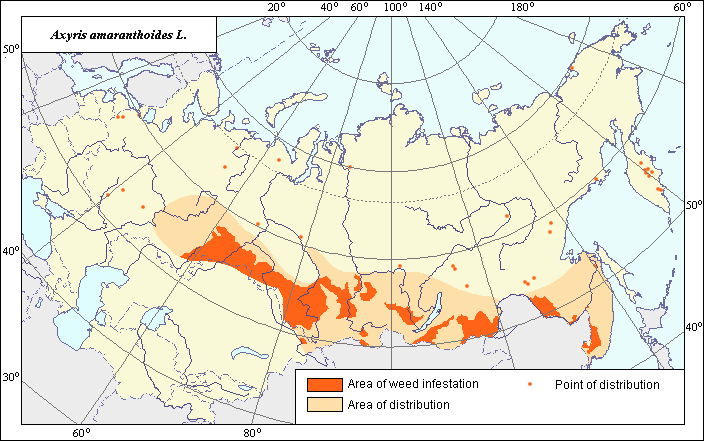Weeds
Area of distribution and weediness of Axyris amaranthoides L.
 Object description Download GIS-layers
Object description Download GIS-layers
Authors:
Biologist specialist - S.Yu.Larina,GIS-specialist - I.A.Budrevskaya.
Date of creation:
17.11.2006.Scale:
1:20 000 000.Accuracy of the map:
It is created on materials of maps of natural scale 1:17 000 000 - 1:100 000 000.Projection:
"Alber's Equal Area Conic for the USSR", 9, 1001, 7, 100, 0, 44, 68, 0, 0.Basic content:
Vector map. Area of distribution is shown by polygon (main distribution) and by dots (sporadic distribution). Zone of weediness is shown by polygon.Accuracy of the classifier:
Within the area of A. amaranthoides the zones of its weediness are shown, established by criteria of occurence (% of fields where this species is found) and abundance (expressed as projective cover of this species in the field (in % to the field area)) (Tanskii et al., 1998), i.e.; where the occurence of this species exceeded 20% with its abundance (projective cover) more than 15%.Method of map production:
The areas of distribution and weediness of A. amaranthoides are established according to the analysis of the open published maps and literature. The area of distribution is based on the map from the publication of A.N.Volkov (1935). The map from the article of V.P.Golubintseva (1936) is used as a reference source. The area is extended to Altai Territory, which is supported by the data of I.M.Krasnoborov & L.I.Malyshev (1992). The zones of weediness are established according to V.V.Nikitin (1983) and coordinated with the limits of arable land. The sites of sporadic distribution of A. amaranthoides are depicted according to A.N.Volkov (1935), A.I.Tolmachev (1976), N.A. Minyaev et al. (1981), I.M.Krasnoborov & L.I.Malyshev (1992), S.S.Kharkevich (1988), the main part of them from the last two sources, supported by the data of A.N.Volkov (1935), is included in the main area.Reference citations:
Anonym. 2006. Russian Pigweed. Syngenta Canada - Guides & Tools: http://www.syngenta.ca/en/guides/weed/index.asp?Nav=pigweed_russianGolubintseva, V.P. 1936. The specific weeds of Siberia. In: Reverdatto, V.V., ed. Transactions of Biological Institute of Tomsk State University. V.2. Tomsk: Tomsk State University. p.170-227. (in Russian).
Keller, B.A., ed. 1934. Weed plants of the USSR. V.2. Leningrad: AN SSSR. 244 p. (in Russian).
Kharkevich, S.S., ed. 1988. Vascular plants of the Soviet Far East. V.3. Leningrad: Nauka. 421 p. (in Russian).
Komarov, V.L. & Shishkin, B.K., eds. 1936. Flora of the USSR. V.6. Moscow-Leningrad: AN SSSR. 954 p. (in Russian).
Krasnoborov, I.M. & Malyshev, L.I., eds. 1992. Flora of Siberia. V.5. Novisibirsk: Nauka. 312 p. (in Russian).
Minyaev N.A., Orlova N.I., Shmidt V.M. 1981. Keys to higher plants of Northwest of European part of the Russian Federation. Leningrad: Publishing House of Leningrad State University. 376 p. (in Russian).
Nikitin, V.V. 1983. Weed plants of the USSR flora. Leningrad: Nauka. 454 p. (in Russian).
Tanskii, V.I., Levitin M.M., Ishkova T.I. & Kondratenko, V.I. 1998. Phytosanitary diagnostics in integrated management of cereals. In: Novozhilov, K.V., ed. Compendium of methodical recommendations in plant protection. Saint-Petersburg: VIZR. p.5-55. (in Russian).
Tolmachev, A.I., ed. 1976. Flora of Northeast of the European part of the USSR. V.2. Leningrad: Nauka. 316 p. (in Russian).
Volkov, A.N., ed. 1935. Areas of distribution of the major weed plants in the USSR. Moscow-Leningrad: Publishing House of Kolchoz & Sovchoz Literature. 153 p. (in Russian).

